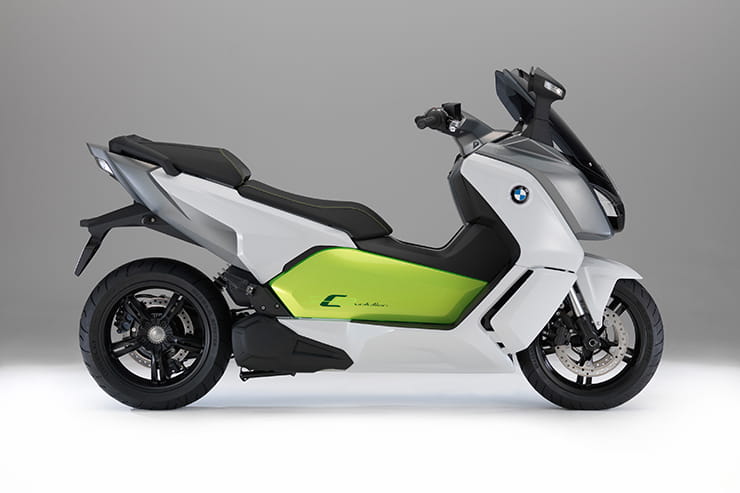In 2014 BMW took the plunge and built their first fully electric motorcycle – the C evolution scooter. While the car side of the business had already invested heavily in electric and hybrid vehicles under the i series banner, this was quite a step for Motorrad as electric power was very much in its infancy in the two-wheeled world where in the four-wheeled word it was far more accepted and advanced. Launched to complement the firm’s mid-sized C650 petrol scooters, the C evolution was aimed more at non-traditional motorcyclists as it was (technically...) a 125cc capacity and therefore could be ridden on an A1-licence. Although a high price tag did put many off, the C evolution appealed to a select group of urban riders and while it has since been updated (in 2020), even today it remains one of the most advanced electric bikes on the market. With used prices now almost half the cost of new, it makes for a tempting and practical urban commuter that is also very cheap to run.
BMW C evolution (2014-2019) Price
New technology is never cheap and in 2014 the C evolution cost a somewhat terrifying £13,500, which was about a third more than BMW’s petrol-powered C650 models. There were various government grants that helped sweeten the package but this was still a big barrier to overcome. Nowadays you can find an early C evolution for as little as £6000, although it will probably have quite a few miles on its clocks and be one of the (few...) that has been heavily used. Aim to spend closer to £7000 and you will get a lower mileage example with later 2019 bikes going for roughly £10,500. When you consider a new 2021 model costs £16,000 and is really only a bit more powerful and has a better range, that’s quite a saving.
Power and torque
This is the key area where electric wins when compared to petrol and the C evolution’s motor delivers lots of instant torque with no need to rev it at all. BMW claimed a very impressive 53.1lb.ft was on offer and when you open the throttle the C evolution is remarkably quick to accelerate – in fact, it is faster than the petrol C650 models. But here is the oddity of electric. Due to the fact peak power is calculated as an average over an hour of the bike running, despite the C evolution making a peak of 47bhp it is technically rated at 15bhp as the battery’s performance drops and therefore so does the power with time, which means it is A1-legal to ride as it has the same performance (on paper...) as a 125cc petrol engine. So basically, if you are over 17 and have completed CBT you can ride one on the road... It’s a quirk of electric vehicles that BMW happily exploited to open up its potential market base.
Engine, gearbox and exhaust
The C evolution uses the same batteries as BMW’s cars, however where the i3 car uses eight batteries, the C evolution has just three, giving it a power rating of 8kWh. The motor is a liquid-cooled permanent magnet design ,which means no maintenance is required, and aside from a drive belt that’s all you need to know. Yet there is one question mark hanging over its head, battery derogation. As anyone who own a smartphone knows, when the battery starts to give up it is extremely annoying as its ability to hold charge reduces. Owners report that the C evolution seems to be very sturdy and used bikes don’t suffer much from this issue, however it is all down to how the battery has been looked after, charge cycles and use so it is a very hard one to determine. Just like a petrol engine, the more use a battery has the faster it will degrade, so lower mileage bikes are a better buy, but this is only a rough guide. A few companies (English Electric Motor Company are two-wheel specialists) can run diagnostic checks on a battery, which is worth exploring. BMW did include several monitoring system in the C evolution and claimed its battery would provide at least 80% of its original capacity after five years, however in reality it seems that the number is far higher, which is reassuring.
BMW C evolution (2014-2019) Economy
BMW claimed the C evolution could cover 62 miles between charges and would take roughly four hours to recharge from a normal domestic supply. With electric, range is heavily dependent on use and if you are in an urban environment it will go up while riding the bike on a dual carriageway hammers the range. And also how you apply the rider modes will affect the range. That said, it costs less than £1.20 in electricity to fully recharge the battery and service costs are minimal, so it is a cheap bike to run.
Handling, suspension, chassis and weight
Cleverly, BMW used the bulky batteries as part of the frame on the C evolution (they are housed in very secure aluminium cases!) and effectively hung the swingarm and forks off them to save weight. While this worked in part, the C evolution still tips the scales at a hefty 265kg, which you notice at low speed. Although a low seat height helps, there is no disguising this bulk at low speed and it is a blessing that BMW thought to add a handy reverse gear to help get it out of parking spaces. On the go the weight is held nice and low so the C evolution actually handles reasonably well, certainly no worse than the C650 models. Fat tyres and a good array of electronics make it reassuring for newer riders and while not as sporty as a TMAX it is fine for urban use with the occasional (short...) ride for fun. When buying used, the chassis is your main area of concern as consumable items such as bearings, tyres, brake pads etc will obviously wear out. It is a good idea to buy a bike with some service history as like petrol-powered bikes, if the brake fluid isn’t change regularly it can damage the ABS system and also a good mechanic will spot and keep on top of any issues before they get too serious.
BMW C evolution (2014-2019) Brakes
BMW’s ABS system comes as standard on the C evolution and it is actually linked to the recuperation system to allow braking energy to not go wasted. The twin front discs offer more than enough stopping power and as the rear’s lever is also on the bars, it is easy to use both front and rear brakes should you need a quick boost of stopping power.
Comfort over distance and touring
With a range of just over 60 miles touring on a C evolution is out of the question, however for urban use it is perfectly comfortable and the screen nice and effective. As with all BMW models, there are accessories that can be bought to make it a bit more comfortable...
Rider aids and extra equipment / accessories
Here is where the C evolution is very impressive indeed. You would have expected a BMW model to come with ABS, and the C evolution does, but it also gets Torque Control Assist (traction control) and four rider modes that are very effective. In Road mode the regeneration operates at 50%, making it less intrusive as it is effectively engine braking, where Eco Pro ups the regeneration to maximum (extending the range by a claimed 10-20%). Stick it in Sail mode and the regen is minimised, making the bike feel like there is next to no engine braking, while Dynamic gives you full acceleration and sharp recuperation for a real sporty feel. All clever stuff and altering the modes really changes the bike’s character and performance. There is also a neat TFT dash, which lacks connectivity. In terms of accessories, a top box is a must for the C evolution as there is limited underseat storage (room for an open face lid and that’s about it under the pillion seat) and heated grips are also recommended.
BMW C evolution (2014-2019) verdict
With the automotive word now turning more and more towards electric, the C evolution makes total sense. Battery life is proving not to be an issue and at £6000-£7000 the C evolution makes far more financial sense. If you have a mainly urban commute, electric is an avenue that is well worth exploring and the C evolution is a good starting point.
Three things we love about the C Evolution…
- Level of tech on a scooter
- Practicality
- Cheap running costs
Three things that I don’t…
- Price to buy is still quite high
- Limited range and worry about battery life
- Heavy weight
BMW C evolution (2014-2019) spec
|
Original price
|
£13,500
|
|
Current price range
|
£6000 - £10,500
|
|
Capacity
|
Technically a 125cc
|
|
Bore x Stroke
|
n/a
|
|
Engine layout
|
n/a
|
|
Engine details
|
Liquid-cooled permanent magnet electric motor
|
|
Power
|
15bhp (11kW) @ 4650rpm
|
|
Torque
|
53.1lb-ft (72Nm) @ 4500rpm
|
|
Top speed
|
75mph
|
|
Transmission
|
Belt final drive
|
|
Average fuel consumption
|
n/a
|
|
Tank size
|
8kwh
|
|
Max range to empty (theoretical)
|
62 miles
|
|
Reserve capacity
|
n/a
|
|
Rider aids
|
ABS, 4 rider modes, traction control, reverse
|
|
Frame
|
Hybrid chassis, diecast aluminium
|
|
Front suspension
|
40mm inverted forks
|
|
Front suspension adjustment
|
None
|
|
Rear suspension
|
Monoshock
|
|
Rear suspension adjustment
|
Adjustable 7-stage spring preload
|
|
Front brake
|
2 x 270mm discs, two-piston calipers. ABS
|
|
Rear brake
|
270mm disc, one-piston caliper. ABS
|
|
Front tyre
|
120/70 - 15
|
|
Rear tyre
|
160/60 - 15
|
|
Rake/Trail
|
24.1°/95mm
|
|
Dimensions
|
2190mm x 947mm x n/a (LxWxH)
|
|
Wheelbase
|
1594mm
|
|
Ground clearance
|
n/a
|
|
Seat height
|
780mm
|
|
Kerb weight
|
265kg
|
Looking for motorbike insurance? Get a quote for this bike with Bennetts motorcycle insurance

















